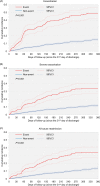Re-exacerbation within 30 days of discharge is associated with poor prognosis in the following year among patients hospitalised with exacerbation of chronic obstructive pulmonary disease: a clinical cohort study
- PMID: 37640511
- PMCID: PMC10462968
- DOI: 10.1136/bmjresp-2023-001759
Re-exacerbation within 30 days of discharge is associated with poor prognosis in the following year among patients hospitalised with exacerbation of chronic obstructive pulmonary disease: a clinical cohort study
Abstract
Background: Exacerbation of chronic obstructive pulmonary disease (ECOPD) is a complex phenomenon, with marked heterogeneity in the aetiology, pathophysiology and clinical manifestations. This study aimed to evaluate the clinical characteristics and long-term outcomes of patients with 30-day exacerbation among those hospitalised with ECOPD in China.
Methods: Data from the Acute Exacerbations of Chronic Obstructive Pulmonary Disease Inpatient Registry were used in this study. The patients were divided into re-event and non-event groups based on the incidence of re-exacerbation within 30 days of discharge. Exacerbation, severe exacerbation and all-cause readmissions in the following 12 months were the outcomes of interest. The cumulative incidence rates and incidence densities were calculated. Multivariate hazard function models were used to determine the association between 30-day re-exacerbation and the long-term outcomes after accounting for the competing risk of death.
Results: Re-exacerbation within 30 days of discharge was observed in 4.9% (n=242) of the patients (n=4963). The cumulative incidence rates and incidence densities of exacerbation, severe exacerbation and all-cause readmissions in the event group were significantly higher than those in the non-event group. After adjustment, re-exacerbation within 30 days of discharge was associated with increased risks of exacerbation, severe exacerbation and all-cause readmissions in the following 12 months (adjusted HR: 3.85 (95% CI: 3.09 to 4.80), 3.46 (2.66 to 4.50) and 3.28 (2.52 to 4.25) accordingly).
Conclusion: Re-exacerbation of COPD within 30 days of discharge is a significant predictor of long-term prognosis. In clinical practice, short-term re-exacerbation is a significant clinical phenotype of ECOPD that requires careful management at the earliest.
Keywords: COPD exacerbations; clinical epidemiology.
© Author(s) (or their employer(s)) 2023. Re-use permitted under CC BY-NC. No commercial re-use. See rights and permissions. Published by BMJ.
Conflict of interest statement
Competing interests: None declared.
Figures




Similar articles
-
Developing and validating prediction models for severe exacerbations and readmissions in patients hospitalised for COPD exacerbation (SERCO) in China: a prospective observational study.BMJ Open Respir Res. 2024 May 7;11(1):e001881. doi: 10.1136/bmjresp-2023-001881. BMJ Open Respir Res. 2024. PMID: 38719500 Free PMC article.
-
Mortality and readmission risk for hospitalised patients with acute exacerbation of COPD with and without spirometric obstruction: a longitudinal observational study in China.BMJ Open. 2023 Jun 5;13(6):e071560. doi: 10.1136/bmjopen-2023-071560. BMJ Open. 2023. PMID: 37277221 Free PMC article.
-
Prompt initiation of triple therapy following hospitalization for a chronic obstructive pulmonary disease exacerbation in the United States: An analysis of the PRIMUS study.J Manag Care Spec Pharm. 2022 Dec;28(12):1366-1377. doi: 10.18553/jmcp.2022.28.12.1366. J Manag Care Spec Pharm. 2022. PMID: 36427341 Free PMC article.
-
Chronic obstructive pulmonary disease exacerbation fundamentals: Diagnosis, treatment, prevention and disease impact.Respirology. 2021 Jun;26(6):532-551. doi: 10.1111/resp.14041. Epub 2021 Apr 24. Respirology. 2021. PMID: 33893708 Review.
-
A 7-point evidence-based care discharge protocol for patients hospitalized for exacerbation of COPD: consensus strategy and expert recommendation.NPJ Prim Care Respir Med. 2024 Dec 20;34(1):44. doi: 10.1038/s41533-024-00378-7. NPJ Prim Care Respir Med. 2024. PMID: 39706845 Free PMC article.
Cited by
-
Exploring risk factors for all-cause hospital readmissions following chronic obstructive pulmonary disease exacerbation patients discharged on steroid tapers.J Thorac Dis. 2024 Dec 31;16(12):8538-8549. doi: 10.21037/jtd-24-932. Epub 2024 Dec 28. J Thorac Dis. 2024. PMID: 39831232 Free PMC article.
References
-
- Global strategy for the diagnosis, management, and prevention of chronic obstructive lung disease: 2023 report. 2022. Available: https://goldcopd.org/2023-gold-report-2/
Publication types
MeSH terms
LinkOut - more resources
Full Text Sources
Medical
